88 暗黒エネルギーとは何か? #暗黒エネルギー
○暗黒エネルギーは宇宙空間を膨張させる。
☆次の2つの性質が想定される。
(1) 実宇宙の境界面での反物質間の斥力が暗黒エネルギーを生み出す。
・・・ただし、これだと宇宙膨張の再加速は説明しにくい。
(2) 暗黒エネルギーは暗黒物質(立体構造を持つ微小粒子)と同じく構造を持つ粒子とも考えられる [1]。
・・・これだと宇宙のインフレーションも説明できる。
・・・宇宙膨張の再加速も説明できる。
⇒宇宙の膨張はやがて唐突に止まる可能性がある。(例)ジャンプ傘
・・・しかし、暗黒エネルギーが下図のような遷移をする場合は、構造を持たなくとも再加速を説明できる。
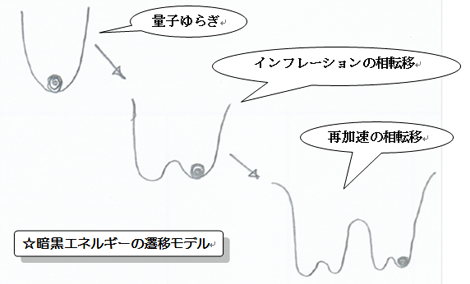
【参 照】
1. No.87-4-2 暗黒物質の構造
○暗黒エネルギーは宇宙空間を膨張させる。
☆次の2つの性質が想定される。
(1) 実宇宙の境界面での反物質間の斥力が暗黒エネルギーを生み出す。
・・・ただし、これだと宇宙膨張の再加速は説明しにくい。
(2) 暗黒エネルギーは暗黒物質(立体構造を持つ微小粒子)と同じく構造を持つ粒子とも考えられる [1]。
・・・これだと宇宙のインフレーションも説明できる。
・・・宇宙膨張の再加速も説明できる。
⇒宇宙の膨張はやがて唐突に止まる可能性がある。(例)ジャンプ傘
・・・しかし、暗黒エネルギーが下図のような遷移をする場合は、構造を持たなくとも再加速を説明できる。

【参 照】
1. No.87-4-2 暗黒物質の構造
87 What is Dark Matter? #darkmatter
編集
87 What is Dark Matter? #darkmatter
87-1 Bullet cluster [1]
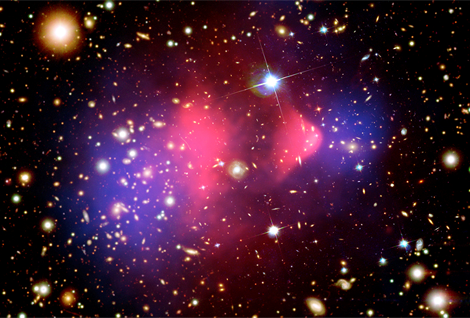
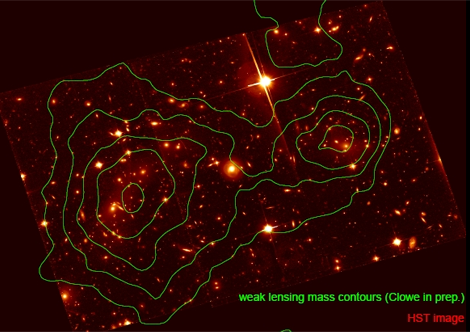
Credit: X-ray: NASA/CXC/CfA/M.Markevitch et al.; Optical: NASA/STScI; Magellan/U.Arizona/D.Clowe et al.; Lensing Map: NASA/STScI; ESO WFI; Magellan/U.Arizona/D.Clowe et al. [2]
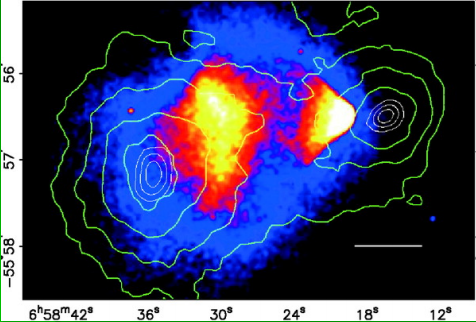
※A galaxy cluster or cluster of galaxies is a structure that consists of anywhere from hundreds to thousands of galaxies bound together by gravity.[2]
※It can be observed both the baryon component and the dark matter component of galaxy clusters by combining the X-ray and a gravitational lens.
※Bullet cluster (1E0657-56) is a very rare high-speed collision. [3]
○The major components of the cluster pair—stars, gas and the putative dark matter—behave differently during collision, allowing them to be studied separately. This accords with prediction of dark matter as only weakly interacting, other than via the gravitational force. [4]
<Deta>
・Collision time:1 00~ 200 million years ago
・Distance:3.7 billion light-years
・The relative speed of two galaxy clusters:4,500 km / s
・The ratio of two galaxy clusters = 1:10
・Current distance of two galaxy clusters:1~2 million light-years
・Mass:10^14~10^15M
・The number of galaxies: several hundred to several thousand
○The hot gas of the two colliding components, seen in X-rays, represents most of the baryonic, i.e. ordinary, matter in the cluster pair.
○The stars of the galaxies, observable in visible light, were not greatly affected by the collision, and most passed right through, gravitationally slowed but not otherwise altered.
87-2 Structure of the Universe/Fluid simulation of the dark matter [5] [6]
<Setting>
・It is necessary to devise for reducing the amount of calculation. (About 550 billion pieces of dark matter particles [7])
・Short-range force is solved by Barnes-Hut treecode(solving properly because the influence is large), long-range force is solved by particle/mesh simulation(summarized because the influence is small).
・In particle/mesh simulation the amount of calculation dramatically increased as the structure develops, but it is prevented by Barnes-Hut treecode.
・Dark energy does not affect much in structure formation.
<Difficulty>
・High-density structures are development everywhere. → divide the dynamic region.
・Gravity is a long-range force. → devise communication algorithm.
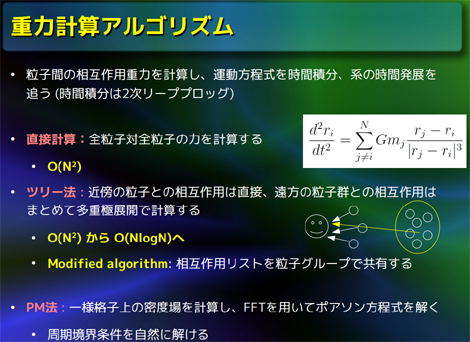

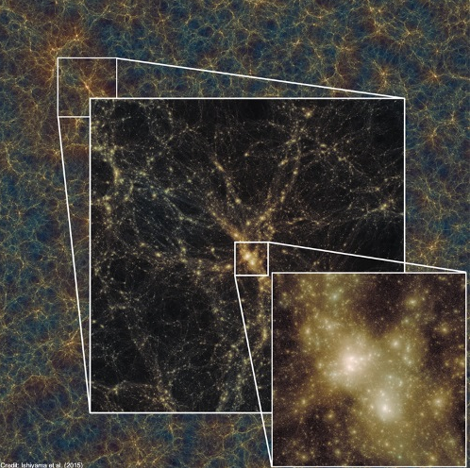
※ The photograph above is an enlarged view of the part of the bottom panel. Lower right is the halo of the largest clusters of galaxies that were formed in this simulation. [7]
87-3 What is Dark matter?
○ Mass of dark particles(particles of dark matter) is 0.3 pieces of hydrogen atoms. [8]
○Density:Dark matter that is included in the earth is 500g. [8]
○Supersymmetric particles are candidates for dark matter. [9]

※ Supersymmetry (SUSY) [10]
☆Dark matter may be a superposition of gravity waves?
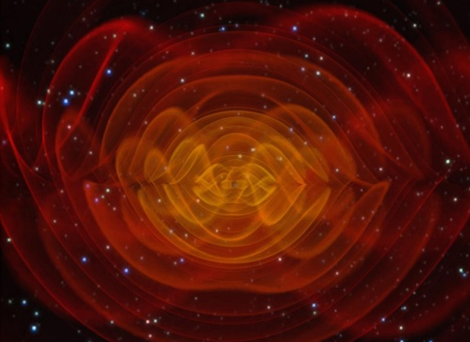
※Gravitational wave generated from collision of two black holes (ILLUSTRATION BY C. HENZE, NASA)
87-4 Gravity of dark matter
87-4-1 Nature of gravity is different?
・Gravity of Substance is represented by F=G・ma・mb/square of L.
(G:gravitational constant、ma・mb:mass、L:distance)
・Dark matter, despite about5 times presence of Substance, is distributed spherically around the galaxy.
・From the above, assuming Gravity of Dark Matter to be represented by
Fd=Gd・ma・mb/n-th power of L,
n is estimated that less than 1.
(Gd:gravitational constant of Dark Matter)
・However, it is difficult to explain the attraction between the substance and the dark matter in this assumption.
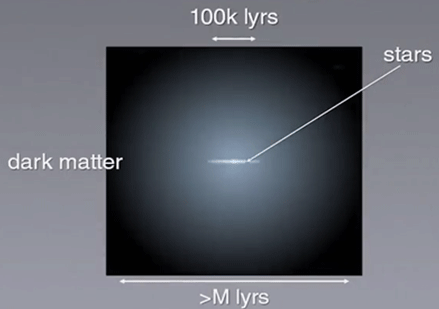
※True nature of galaxies [11]
☆ If dark matter is a superposition of gravity waves, this idea is not necessary.
87-4-2 A Structure of Dark Matter
May 19, 2016 Publication
○I wish to suggest a structure for dark matter. This structure has novel features which are of considerable cosmological interest.
○A structure for particles of dark matter(:dark particles) has not been proposed yet. Only the models of large scale structure of the universe are proposed. In my opinion, these models are unsatisfactory for two reasons:
(1)I believe that the retention force which gives the dark matter halo is the structure of dark particles, not the nature of gravity. Without the structure of dark particles it is not clear what dark matter halo would hold such large structure.
(2)The models of large scale structure appear to be too large.
○Atomic structure is almost empty, however has a large volume. In Bohr model [12] the size of atom is a diffuse cloud of negatively charged electrons surrounding a small, dense, positively charged nucleus.
○I wish to put forward a new structure for dark matter. This structure is something stereoscopic based on sphere. Several models are considered. (see Figure1)
○I have made the usual quantum physical assumptions, namely, that each dark particles in close proximity are held in a single orbit by the centripetal force of gravity.
The two orbits are related by electromagnetic radiation. But such radiation is not observed.
○Each dark matter clusters pass with little affected in the collision of galaxy clusters. I have assumed the radius of the orbit is much larger than particle.
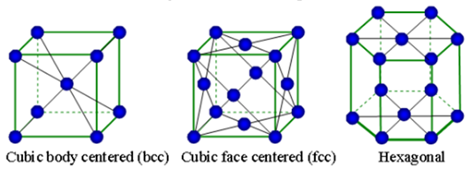
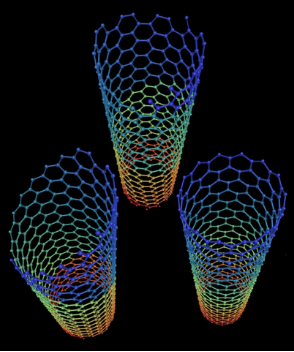
Figure1 Examples of the structure [13] [14]
○The dark matter halo surrounding the spiral galaxy appears to have 10 times huge spherical structure of the galaxy. If dark matter forms such 3-dimensional structure, then the huge structure is automatically determined. (see Figure2)
○The dark matter halo always has been suggested the existence of the particle structure.

Figure2 True nature of galaxies [11]
○It has not escaped my notice that the structure of dark matter I have postulated immediately suggests a possible quest for identity of the dark matter.
I am much indebted to Internet, especially Google and Wikipedia for constant information.
I have also been stimulated by knowledge of the online course of cosmology of Dr. Brian Schmidt and Dr. Paul Francis at Australian National University [15], Hitoshi Murayama at The University of Tokyo [11].
87-4-3 Method of verifying the structure of dark matter:Gravity wave analysis experiment in outer space
☆ When the dark matter has a structure, the gravitational wave is strongly scattered at a specific angle.
☆ Therefore, gravity waves with different strengths will be observed at different places in outer space.
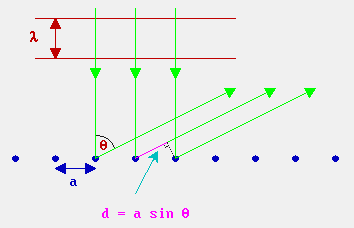
※Example of electron beam analysis [16]
87-4-4 Twist of Supersymmetry [8]
:In the supersymmetry, bose particles (that convey the force) is the material particles.
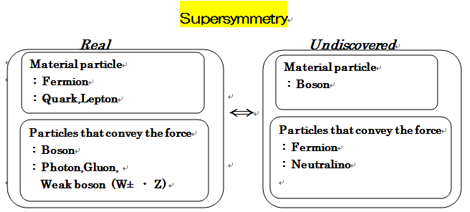
<Conclusions ☆>Dark matter is supersymmetry Bose particle and has 3-dimensional structure.
87-4-5 Dark Matter and Black Hole
○Because dark matter has 3-dimensional structure,we can estimate that Dark Matter is difficult to form a Black Hole compared to Substance.
【References】
1. NASA “CHANDRA”
http://chandra.harvard.edu/photo/2006/1e0657/index.html
2. Galaxy cluster - Wikipedia
3. Doug Marett“The Bullet Cluster: Evidence for Dark Matter or Not?”2013
http://www.conspiracyoflight.com/Cosmology/Bullet.html
4. Bullet cluster - Wikipedia
5. 石山智明“スーパーコンピューターの中で生まれる宇宙”
https://www.ssken.gr.jp/MAINSITE/download/newsletter/2012/20121024-sci-2/lecture-01/SSKEN_sci2012-2_ishiyama_presentation.pdf
6. 石山智明”世界最大のシミュレーションでダークマターの正体にせまる” 2013 -You Tube
https://www.youtube.com/watch?v=QsBiGS2zq-8
7. 国立天文台“宇宙初期から現在に至る世界最大規模のダークマターシミュレーション”
http://www.astroarts.co.jp/news/2015/05/07simulation/index-j.shtml
8. 蓑輪眞“暗黒物質の正体は何か?”
http://www.resceu.s.u-tokyo.ac.jp/symposium/daigaku&kagaku/MINOWA.pdf
9. 浅井祥仁”「テラスケール物理」領域の概要”
http://www.icepp.s.u-tokyo.ac.jp/terascale/overview.html
10.Dennis SILVERMAN”More About Supersymmetry”
http://sites.uci.edu/energyobserver/2012/12/02/update-on-some-higgs-blog-entries/
11. Hitoshi Murayama“From the Big Bang to Dark Energy” Coursera of The University of Tokyo
https://www.coursera.org/learn/big-bang?utm_campaign=opencourse.bV6GUWEbEeSceSIACy-PDA.opencourse.announcements~opencourse.bV6GUWEbEeSceSIACy-PDA.instructorCourseStart&utm_medium=email&utm_source=other
12. Bohr model - Wikipedia
13.Substances &Technologies
http://www.substech.com/dokuwiki/doku.php?id=metals_crystal_structure
14.The Univercity of Arizona
http://news.engr.arizona.edu/news/materials-science-and-engineering-students-win-best-poster-professional-meetings-0
15. edX ” Astrophysics: Cosmology
https://www.edx.org/course/astrophysics-cosmology-anux-anu-astro4x
16. Low Energy Electron Diffraction
http://www.chem.qmul.ac.uk/surfaces/scc/scat6_2.htm
87-1 Bullet cluster [1]


Credit: X-ray: NASA/CXC/CfA/M.Markevitch et al.; Optical: NASA/STScI; Magellan/U.Arizona/D.Clowe et al.; Lensing Map: NASA/STScI; ESO WFI; Magellan/U.Arizona/D.Clowe et al. [2]

※A galaxy cluster or cluster of galaxies is a structure that consists of anywhere from hundreds to thousands of galaxies bound together by gravity.[2]
※It can be observed both the baryon component and the dark matter component of galaxy clusters by combining the X-ray and a gravitational lens.
※Bullet cluster (1E0657-56) is a very rare high-speed collision. [3]
○The major components of the cluster pair—stars, gas and the putative dark matter—behave differently during collision, allowing them to be studied separately. This accords with prediction of dark matter as only weakly interacting, other than via the gravitational force. [4]
<Deta>
・Collision time:1 00~ 200 million years ago
・Distance:3.7 billion light-years
・The relative speed of two galaxy clusters:4,500 km / s
・The ratio of two galaxy clusters = 1:10
・Current distance of two galaxy clusters:1~2 million light-years
・Mass:10^14~10^15M
・The number of galaxies: several hundred to several thousand
○The hot gas of the two colliding components, seen in X-rays, represents most of the baryonic, i.e. ordinary, matter in the cluster pair.
○The stars of the galaxies, observable in visible light, were not greatly affected by the collision, and most passed right through, gravitationally slowed but not otherwise altered.
87-2 Structure of the Universe/Fluid simulation of the dark matter [5] [6]
<Setting>
・It is necessary to devise for reducing the amount of calculation. (About 550 billion pieces of dark matter particles [7])
・Short-range force is solved by Barnes-Hut treecode(solving properly because the influence is large), long-range force is solved by particle/mesh simulation(summarized because the influence is small).
・In particle/mesh simulation the amount of calculation dramatically increased as the structure develops, but it is prevented by Barnes-Hut treecode.
・Dark energy does not affect much in structure formation.
<Difficulty>
・High-density structures are development everywhere. → divide the dynamic region.
・Gravity is a long-range force. → devise communication algorithm.



※ The photograph above is an enlarged view of the part of the bottom panel. Lower right is the halo of the largest clusters of galaxies that were formed in this simulation. [7]
87-3 What is Dark matter?
○ Mass of dark particles(particles of dark matter) is 0.3 pieces of hydrogen atoms. [8]
○Density:Dark matter that is included in the earth is 500g. [8]
○Supersymmetric particles are candidates for dark matter. [9]

※ Supersymmetry (SUSY) [10]
☆Dark matter may be a superposition of gravity waves?

※Gravitational wave generated from collision of two black holes (ILLUSTRATION BY C. HENZE, NASA)
87-4 Gravity of dark matter
87-4-1 Nature of gravity is different?
・Gravity of Substance is represented by F=G・ma・mb/square of L.
(G:gravitational constant、ma・mb:mass、L:distance)
・Dark matter, despite about5 times presence of Substance, is distributed spherically around the galaxy.
・From the above, assuming Gravity of Dark Matter to be represented by
Fd=Gd・ma・mb/n-th power of L,
n is estimated that less than 1.
(Gd:gravitational constant of Dark Matter)
・However, it is difficult to explain the attraction between the substance and the dark matter in this assumption.

※True nature of galaxies [11]
☆ If dark matter is a superposition of gravity waves, this idea is not necessary.
87-4-2 A Structure of Dark Matter
May 19, 2016 Publication
○I wish to suggest a structure for dark matter. This structure has novel features which are of considerable cosmological interest.
○A structure for particles of dark matter(:dark particles) has not been proposed yet. Only the models of large scale structure of the universe are proposed. In my opinion, these models are unsatisfactory for two reasons:
(1)I believe that the retention force which gives the dark matter halo is the structure of dark particles, not the nature of gravity. Without the structure of dark particles it is not clear what dark matter halo would hold such large structure.
(2)The models of large scale structure appear to be too large.
○Atomic structure is almost empty, however has a large volume. In Bohr model [12] the size of atom is a diffuse cloud of negatively charged electrons surrounding a small, dense, positively charged nucleus.
○I wish to put forward a new structure for dark matter. This structure is something stereoscopic based on sphere. Several models are considered. (see Figure1)
○I have made the usual quantum physical assumptions, namely, that each dark particles in close proximity are held in a single orbit by the centripetal force of gravity.
The two orbits are related by electromagnetic radiation. But such radiation is not observed.
○Each dark matter clusters pass with little affected in the collision of galaxy clusters. I have assumed the radius of the orbit is much larger than particle.


Figure1 Examples of the structure [13] [14]
○The dark matter halo surrounding the spiral galaxy appears to have 10 times huge spherical structure of the galaxy. If dark matter forms such 3-dimensional structure, then the huge structure is automatically determined. (see Figure2)
○The dark matter halo always has been suggested the existence of the particle structure.

Figure2 True nature of galaxies [11]
○It has not escaped my notice that the structure of dark matter I have postulated immediately suggests a possible quest for identity of the dark matter.
I am much indebted to Internet, especially Google and Wikipedia for constant information.
I have also been stimulated by knowledge of the online course of cosmology of Dr. Brian Schmidt and Dr. Paul Francis at Australian National University [15], Hitoshi Murayama at The University of Tokyo [11].
87-4-3 Method of verifying the structure of dark matter:Gravity wave analysis experiment in outer space
☆ When the dark matter has a structure, the gravitational wave is strongly scattered at a specific angle.
☆ Therefore, gravity waves with different strengths will be observed at different places in outer space.

※Example of electron beam analysis [16]
87-4-4 Twist of Supersymmetry [8]
:In the supersymmetry, bose particles (that convey the force) is the material particles.

<Conclusions ☆>Dark matter is supersymmetry Bose particle and has 3-dimensional structure.
87-4-5 Dark Matter and Black Hole
○Because dark matter has 3-dimensional structure,we can estimate that Dark Matter is difficult to form a Black Hole compared to Substance.
【References】
1. NASA “CHANDRA”
http://chandra.harvard.edu/photo/2006/1e0657/index.html
2. Galaxy cluster - Wikipedia
3. Doug Marett“The Bullet Cluster: Evidence for Dark Matter or Not?”2013
http://www.conspiracyoflight.com/Cosmology/Bullet.html
4. Bullet cluster - Wikipedia
5. 石山智明“スーパーコンピューターの中で生まれる宇宙”
https://www.ssken.gr.jp/MAINSITE/download/newsletter/2012/20121024-sci-2/lecture-01/SSKEN_sci2012-2_ishiyama_presentation.pdf
6. 石山智明”世界最大のシミュレーションでダークマターの正体にせまる” 2013 -You Tube
https://www.youtube.com/watch?v=QsBiGS2zq-8
7. 国立天文台“宇宙初期から現在に至る世界最大規模のダークマターシミュレーション”
http://www.astroarts.co.jp/news/2015/05/07simulation/index-j.shtml
8. 蓑輪眞“暗黒物質の正体は何か?”
http://www.resceu.s.u-tokyo.ac.jp/symposium/daigaku&kagaku/MINOWA.pdf
9. 浅井祥仁”「テラスケール物理」領域の概要”
http://www.icepp.s.u-tokyo.ac.jp/terascale/overview.html
10.Dennis SILVERMAN”More About Supersymmetry”
http://sites.uci.edu/energyobserver/2012/12/02/update-on-some-higgs-blog-entries/
11. Hitoshi Murayama“From the Big Bang to Dark Energy” Coursera of The University of Tokyo
https://www.coursera.org/learn/big-bang?utm_campaign=opencourse.bV6GUWEbEeSceSIACy-PDA.opencourse.announcements~opencourse.bV6GUWEbEeSceSIACy-PDA.instructorCourseStart&utm_medium=email&utm_source=other
12. Bohr model - Wikipedia
13.Substances &Technologies
http://www.substech.com/dokuwiki/doku.php?id=metals_crystal_structure
14.The Univercity of Arizona
http://news.engr.arizona.edu/news/materials-science-and-engineering-students-win-best-poster-professional-meetings-0
15. edX ” Astrophysics: Cosmology
https://www.edx.org/course/astrophysics-cosmology-anux-anu-astro4x
16. Low Energy Electron Diffraction
http://www.chem.qmul.ac.uk/surfaces/scc/scat6_2.htm
0 件のコメント:
コメントを投稿